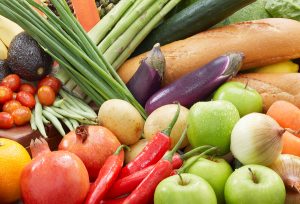 With so much selection, choosing climate-friendly fruits and vegetables can be overwhelming. The following are a few suggestions that may help consumers make informed decisions.
With so much selection, choosing climate-friendly fruits and vegetables can be overwhelming. The following are a few suggestions that may help consumers make informed decisions.
- Growing your own fruits and vegetables is the best solution for reducing your food associated GHGs. Gardening does not have to take the form of a backyard plot, but instead food can be grown in indoor pots, garden boxes, or community garden spaces. Collaborating with your neighbours to trade produce is a great way to ensure you have an array of veggies.
- Buy what is in season. (Here is Sobey’s Regional Produce Chart for Western Canada)
Local or Imported?
While supporting Canadian farmers is ideal, some “local” produce may actually have larger carbon footprints.
For example, most Canadian tomatoes are grown in greenhouses in Southern Ontario. While trucking produce from Ontario, rather than Mexico, would save greenhouse gas emissions associated with transportation, the production emissions from the greenhouses are actually much higher than the transportation emissions. Therefore, sometimes you have to do a bit of math.
If it’s not in season in Canada, choose the next closest North American choice. If you have a choice between Canadian apples and ones from South Africa, that might be a case where you choose “local”.
Case Study: Juice
Juice is an incredibly energy-intensive form of gaining nutrition. For approximately every tonne of orange juice consumed, at least 25 tonnes of other materials were required, including 22 tonnes of water and 0.1 tonne of fuel (3). Additionally, a heavy use of pesticides and a vast amount of land is required.
Most of the world’s orange juice growing land is in Brazil, resulting in carbon sequestering forests being removed simply for juice.
Concentrate vs fresh
Processing juice is also very energy intensive. First, all juice must be pasteurized using high heat. Then, juice that is from-concentrate requires vast amounts of energy to evaporate the water. (Plus, new water is later required to mix with the concentrate.)
For all this work, one from-concentrate orange juice plant produces similar annual emissions to that of 1,700 vehicles (more info found here). For transportation, juice that is not-from-concentrate requires 5-6 times more space to transport than that which is from-concentrate. However, these emissions are dwarfed by the from-concentrate processing emissions.
Therefore, if you must have juice, not-from-concentrate is more environmentally friendly. If you do choose from-concentrate, it is better to pick the frozen cans rather than the rehydrated boxed version.
Thinking about buying a load of oranges and making your own juice? While saving the processing emissions, it takes much more space to truck the oranges than the equivalent in juice. On a positive side, juice manufacturers claim that all of the orange parts are used in various ways, including for biofuels, livestock feed, and food flavouring oils.
Alternative Solution: Consider making your own juice using cranberries, crab apples, and other Manitoba-grown fruits.




